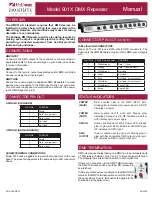
Cabinet Heater G*Y/D*Y Series
INSTALLATION, OPERATION, & MAINTENANCE MANUAL
12
SECTION ONE — Installation, Cont'd.
If coil and valve package connections are to be made
with a “sweat” or solder joint, care should be taken to
assure that no components in the valve package are
subjected to a high temperature which may damage
seals or other materials. Many two-position electric
control valves, depending on valve operation, are
provided with a manual opening lever. This lever
should be placed in the “open” position during all
soldering or brazing operations.
Ground-Joint seal preparation for copper unions
(recommended by manufacturer):
1. Make sure the ground joint area is free of
nicks and scratches.
2. Spray the ground-joint area with silicone
spray for beeswax to enhance seating.
3. Recommended torques for ground joint seal:
½” (nominal) unions – 35 ft./lbs. (minimum)
¾” (nominal) unions – 60 ft./lbs. (minimum)
4. Make sure alignment of line does not put
lateral stress on the ground-joint seal.
5. Make sure that excess solder droplets do not
reach the ground-joint area.
If the valve package connection at the coil is made with
a union, the coil side of the union must be prevented
from twisting (“backed up”) during tightening to
prevent damage to the coil tubing. Over-tightening
must be avoided to prevent distorting (“egg shaping”)
the union seal surface and destroying the union.
The supply and return connections are marked on
the coil stub-outs and the valve package, with an “S”
meaning supply or inlet and “R” meaning return or
outlet indicating flow direction to and from the coil.
Red letters mark the hot water connections.
1. For DXY and DBY units, factory provides tube
extensions to penetrate the rear of the fan coil
cabinet. Hot extension tubes must be properly
insulated.
Hydronic Heating Connections
After mounting the unit, it is then ready for the various
service connections such as water and electrical. At this
time, it should be verified that the proper types of services
are actually provided to the unit. On those units requiring
hot water, the proper line size and water temperature
should be available to the unit.
CAUTION: Toxic residues and loose particles
resulting from manufacturing and field piping
techniques such as joint compounds, soldering flux, and
metal shavings may be present in the unit and the
piping system. Special consideration must be given to
system cleanliness when connecting to solar, domestic
or potable water systems.
Submittals and product literature detailing unit operation,
controls, and connections should be thoroughly reviewed
BEFORE beginning the connection of the various cooling
and/or heating mediums to the unit.
1. Auxiliary Drain Pan
An optional auxiliary drain pan is available for coil
draining.
The auxiliary drain pan is shipped loose from the
factory and must be installed directly below the coil
drain.
The auxiliary drain pan is situated to the inner-case
leg by way of either supporting tabs extending from
the case leg or by way of slots in the case leg. The
drain pipe or a drain trap is then connected to the
stub-out off the bottom of the pan. Confirm that the
pan is secure and positioned for proper operation.
2. Valve Package Install (when applicable)
NOTE: Always protect hot water valve bodies,
strainers, ball valves, and other flow control related
devices from heat caused by soldering or brazing
processes by wrapping these devices in cold or
damp rags.
All accessory valve packages should be installed as
required, and all service valves should be checked for
proper operation.













































